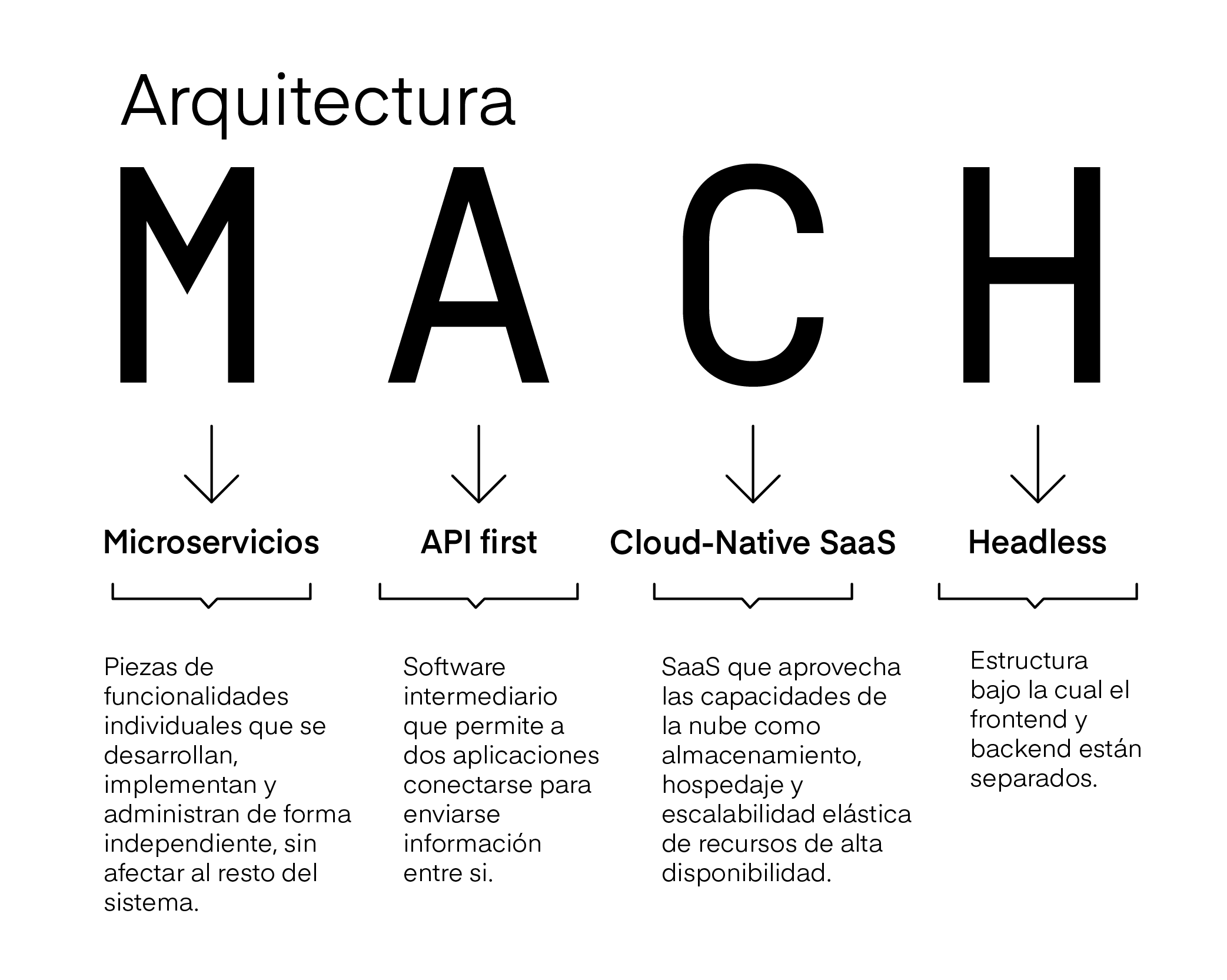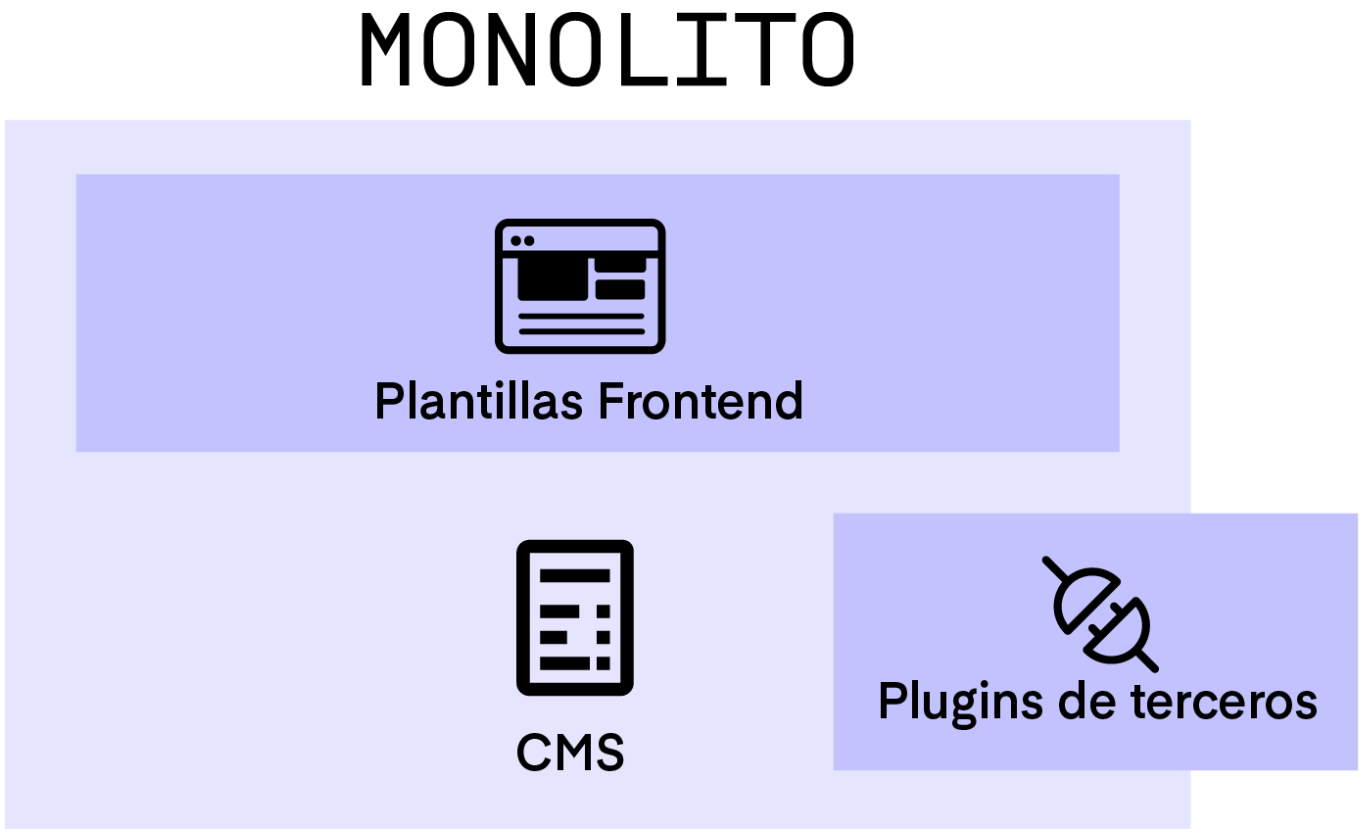What is MACH Architecture and what are its advantages?

MACH stands for Microservices, API-first, Cloud-native SaaS, and Headless. This software architecture proposes to integrate the best-in-class technologies into a single, customized application.

Many companies base their applications on monolithic platforms known as suites.
These suites help companies manage their application through a single platform. They typically offer most of the features that a site needs, such as interface design, content management, database, search engine, commerce, personalization, analytics, and marketing tools.

However, basing your application on a monolithic technology entails several problems. To begin with, no manufacturer has the best technological solution for all the needs of companies. That is, there is no single platform that has the best CMS, the best e-commerce platform, the best search engine, the best payment processor, etc. So, if you use a complete suite from a single provider, you will be limited by the same capabilities of the tool.
You should also consider that by selecting a monolithic platform, your business will depend on a single manufacturer. So, your company will advance as fast as your provider allows you to. If you need new features or improvements to evolve the experience of your application, you will have to wait for vendor updates.
In addition, your developers are limited in creating and developing your application since monolithic platforms are usually incompatible with the most modern languages and libraries in the market.
The MACH technologies come to propose the solution to these problems.
What is MACH?
MACH stands for Microservices, API, Cloud native SaaS, and Headless. This software architecture suggests integrating the best-in-class technologies into a single customized application.

Microservices
Microservices are concrete, independent functions that work together to provide the complete functionality of an application. Each microservice can be updated or scaled without affecting the availability of other units and the application as a whole. Essentially, they are pieces of individual functionality that are developed, deployed, and managed independently.
API
API is an abbreviation for Application Programming Interface. It is a middleware software that allows two applications to send information to each other. Essentially, it is a tool that connects two applications.
Cloud-Native SaaS
Software as a Service that leverages cloud capabilities such as storage, hosting, and elastic scaling of high-availability resources. Functionalities are automatically updated, eliminating the need for update management.
Headless
A structure in which the frontend (user interface) and backend (business logic) are separated, allowing development teams more freedom in interface design and delivering content to multiple channels (website, mobile app, virtual reality device, smart TVs, smartwatches, etc.). While relatively new in the industry, MACH is rapidly gaining popularity for the way it helps businesses.
MACH technologies support a composable business, meaning that each component is connectable, scalable, replaceable, and can be continuously improved. MACH architecture gives businesses the freedom to choose from the best market solutions and maintain a structure that makes it easy to add, replace, or remove those tools in the future.
What are the advantages of a MACH architecture?
Improve performance
MACH architectures run in the cloud, so scalability, infrastructure, or potential load peaks are not a problem. You can be sure that your application will not have performance issues.
Accelerate development speed
MACH technologies are designed to quickly integrate with your technology stack through APIs. And not only that, they are designed to let you use the most modern and advanced programming languages and libraries on the market. Also, by using microservices, you can develop, update, and scale platform-specific, independent services without risking the overall performance of your platform.
As a result, your developers will be able to release new features in less time. And in a rapidly growing digital market, agility is key to staying competitive.
Integrate the best technologies
One of the significant challenges of monolithic platforms is that integrating new tools not belonging to the original manufacturer becomes very complex. Additionally, your brand's digital experience is compromised by the manufacturer's limitations.
In a monolithic platform, if the search engine is not good and does not provide the best search experience for your customers, you will have many headaches trying to improve it. Practically, you would have to wait for the manufacturer to decide to improve their search engine.
On the other hand, MACH architecture allows you to integrate the best search engine, the best CMS, the best CRM, the best personalization platform, etc.
Automatic updates
One of the significant advantages of MACH technologies is that being Cloud-Native SaaS, software updates are automatically done by the provider. This will save your systems team maintenance time.
Convert your platform to omnichannel
Through a Headless architecture, you can adapt your content for delivery on any channel, such as websites, mobile apps, smartwatches, or virtual reality devices. This way, you can develop an omnichannel communication strategy that allows you to serve your customers on multiple channels.
Don't depend on a manufacturer
Perhaps one of the less obvious advantages of MACH is that your application does not depend on a single provider. In such a way that if you perceive that a technology is no longer good enough for your technology stack and the experience you deliver to your customers, you can remove that piece and replace it with another.
Deliver the best experience
All these technical development advantages result in a better user experience. When you have the best tools integrated into your site, you can easily edit your site's design, provide better search results, personalize the user journey, gain better analytics of your users' behavior, offer multiple payment methods, and effectively execute marketing campaigns. This is where the real impact of a MACH architecture is seen.
Challenges of implementing MACH architecture
Greater technical complexity
One of the significant advantages of selecting a monolithic technology is that these tools are designed for a fast and smooth implementation that does not require significant costs or time for the development team. You accelerate your development times but lose the flexibility to optimize your application.
By implementing a MACH architecture, you can deliver a better experience to your consumers, but it involves greater technical complexity in developing your products. You will need a team of developers with software architecture knowledge and the ability to integrate new technologies.
Select the best technologies
There are multiple technologies on the market that you can integrate into your application.
However, selecting the best technology for your company's needs will require a lot of prior research, from knowing the functionalities of the solution to understanding the technical features of the tool. Although it is easy to remove and replace solutions in a MACH architecture, vendors require you to remain with their technology for a contractually obligated period.
Moreover, by the time you realize that the solution you chose simply is not working for you, you will have lost time to achieve your business goals.
Should I switch to a MACH architecture?
Implementing a MACH architecture involves a lot of time, resources, and capital. A poorly implemented MACH architecture can result in subpar digital products that do not allow you to meet your users' expectations.
We only recommend switching to a MACH architecture if:
You lead a team of developers with enough experience to integrate multiple technologies into a single customized application.
You manage a team of marketers, designers, and analysts capable of making the most of each solution you integrate into your application.
You have access to sufficient budget to pay for the best technologies on the market.
Your company always seeks to deliver the best experience to its users.


